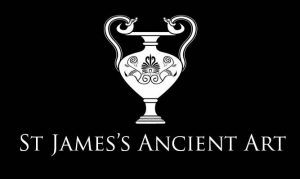In Roman mythology, Fortuna was the personification of good fortune and chance, but was also worshipped as the protector of cities, hence the mural-crown she is shown wearing, which symbolises the city the goddess is protecting. Fortuna, known as Tyche in Greek mythology, appears not only in bronze sculptures, but also on coins, stone reliefs, glass perfume bottles and stone sculptures. Bronze statuettes and appliques depicting Fortuna were created to commemorate a specific city. Considering the particular way in which the drapery folds around the figure’s face, this applique might find its iconographical prototype in the famous Hellenistic bronze statue Tyche of Antioch, sculpted by Eutychides in the early 3rd century BC. The statue, like most of Greek bronze statuary, is known thank to a Roman marble reproduction, now at the Vatican Museums in Rome. Reduced scale bronze copies of the Eutychides’ Tyche have been recovered throughout the late Roman and early Byzantine worlds.
To learn more about everyday bronze items in the Classical World, visit our relevant post: Everyday Items in the Classical World.



